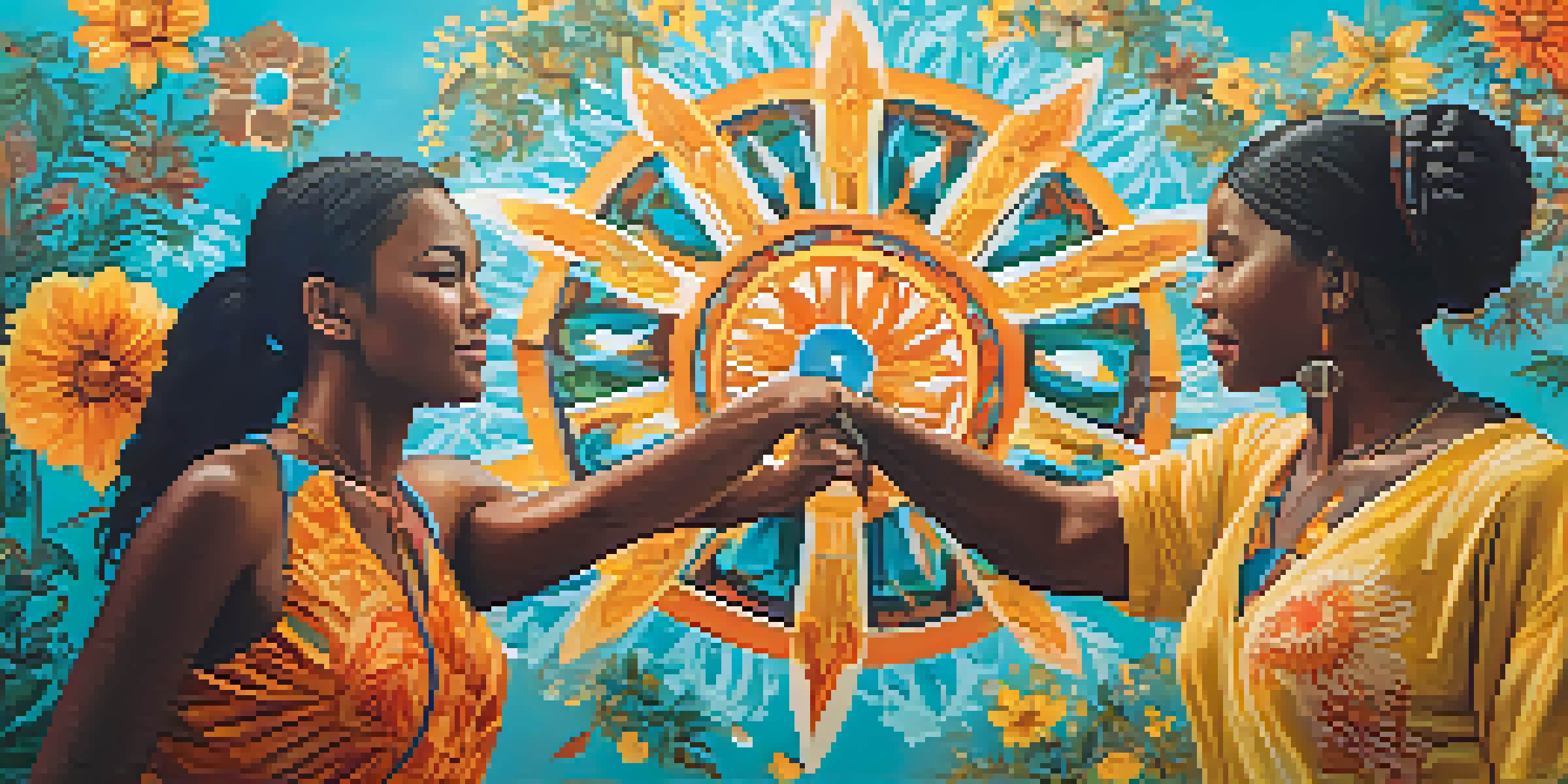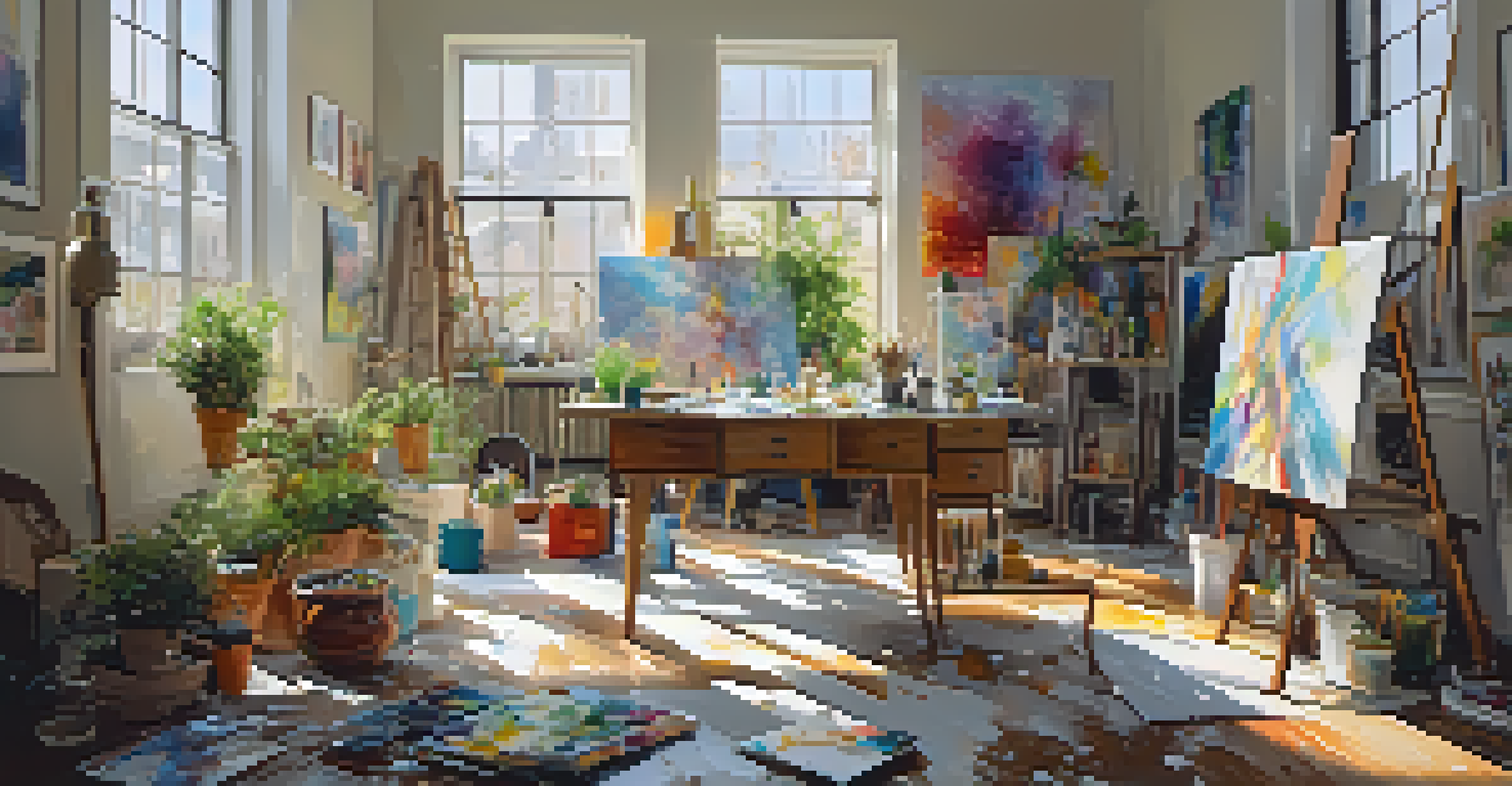Art, Emotion, and Connection: A Psychological Perspective

Understanding the Emotional Impact of Art
Art has a unique ability to evoke emotions, often tapping into our innermost feelings. Whether it’s a vibrant painting or a haunting piece of music, art can stir joy, sadness, or nostalgia with just a glance or a note. This emotional reaction is not merely subjective; it has deep psychological roots that influence how we perceive and interact with the world around us.
Art is the most beautiful of all lies.
Psychologists suggest that our emotional responses to art are linked to personal experiences and memories. When we encounter a piece of art, we often unconsciously relate it to our own life stories, interpreting it through our unique lens. This connection can create a sense of empathy and understanding, allowing us to process our feelings in a safe, external context.
Furthermore, the emotional impact of art can serve as a catalyst for personal growth and healing. Many therapy practices incorporate art as a form of expression, helping individuals articulate complex emotions that may be hard to verbalize. Through this process, art becomes not just a form of creativity, but a bridge to emotional exploration and connection.
The Role of Art in Fostering Human Connections
Art is often viewed as a solitary pursuit, but its true power lies in its ability to connect people. From galleries to street murals, art brings individuals together, sparking conversations and shared experiences. This communal aspect of art can create bonds among strangers, transforming mere observers into participants in a collective dialogue.

Consider a public art installation: as people gather around, they share their interpretations and feelings about the piece. This exchange can lead to deeper discussions about life, society, and personal perspectives. In this way, art acts as a common language, breaking down barriers and fostering understanding among diverse groups of people.
Art Evokes Deep Emotional Responses
Art connects with our personal experiences, allowing us to process complex feelings through emotional expression.
Moreover, collaborative art projects, such as community murals or group exhibitions, further enhance these connections. Participants not only contribute their creative skills but also share personal stories and insights. This collaboration nurtures a sense of belonging, reminding us of our shared humanity through the lens of creativity.
How Art Reflects and Shapes Cultural Emotions
Art is a mirror reflecting the emotions and values of a culture at any given time. Historical events, societal changes, and collective feelings are often captured in artistic expressions, providing insight into the emotional landscape of a community. For instance, art movements like Expressionism emerged in response to societal turmoil, encapsulating the anxiety and despair of the era.
The best artist has no conception that a marble block does not contain within itself.
By examining art from different cultures and periods, we can gain a better understanding of the emotional currents that shaped those societies. This exploration reveals how art not only reflects emotions but also helps to shape them, influencing public sentiment and cultural identity. Artists often channel their feelings into their work, which can inspire or provoke emotional responses in viewers.
In today's world, contemporary art continues to respond to current issues such as climate change, social justice, and mental health. Artists become voices for their communities, using their work to evoke awareness and action. This ongoing dialogue between art and culture illustrates the dynamic relationship where emotions are both expressed and experienced collectively.
The Neuroscience Behind Art and Emotion
Recent studies in neuroscience have shed light on how our brains react to art. When we experience something visually or sonically stimulating, our brain releases neurotransmitters like dopamine, which contribute to feelings of pleasure and reward. This biological response is why certain pieces of art can make us feel elated, energized, or even moved to tears.
Moreover, the brain's mirror neuron system plays a critical role in our emotional responses to art. This system allows us to empathize with the emotions conveyed by artists, making us feel a connection to their experiences. For example, seeing an artwork that depicts sorrow can evoke a similar feeling in us, as if we are sharing the artist's emotional journey.
Art Fosters Community Connections
Through shared experiences and collaborative projects, art builds bonds and enhances understanding among diverse groups.
Understanding this neuroscience not only enhances our appreciation of art but also highlights its therapeutic potential. Art therapy, for instance, harnesses these neurological responses to help individuals process emotions and heal from trauma. By engaging with art, we tap into a powerful emotional reservoir that can facilitate personal transformation.
Art as a Tool for Emotional Expression
For many, art serves as a vital outlet for emotional expression. Whether through painting, writing, or music, creating art allows individuals to convey feelings that might be difficult to articulate in words. This act of creation can be cathartic, providing a sense of relief and clarity as emotions are externalized.
The process of making art can also be therapeutic in itself. Engaging in creative activities has been shown to reduce stress and anxiety, offering a mental escape from the chaos of daily life. When we immerse ourselves in the creative process, we enter a state of flow, where worries fade away and emotional expression takes center stage.
Furthermore, sharing our art with others can amplify this emotional release. Whether it's through a gallery exhibit or a simple social media post, displaying our work invites feedback and connection. This communal appreciation can validate our feelings, reinforcing that we are not alone in our emotional experiences.
Art and Emotional Resilience in Times of Crisis
In times of crisis, art often emerges as a powerful tool for emotional resilience. Whether it’s during personal hardships or global calamities, art provides a means to process grief, anger, and fear. For example, many artists have used their platforms to address and reflect on the emotions surrounding events like natural disasters or social injustices.
Creating and consuming art during difficult times can foster a sense of hope and connection. It reminds us of our shared struggles and experiences, creating a collective narrative that resonates deeply with many. This shared emotional journey helps individuals feel less isolated, promoting healing and understanding within communities.
Art as a Catalyst for Healing
Engaging with art can promote emotional resilience, helping individuals navigate personal and collective crises.
Moreover, public art initiatives during crises—like murals that honor victims or installations that inspire hope—can galvanize communities. These projects not only beautify spaces but also serve as poignant reminders of resilience and solidarity. In this way, art becomes a beacon of light in dark times, showcasing the strength of human emotion and connection.
The Future of Art in Emotional and Social Connection
As we look to the future, the role of art in fostering emotional and social connections is likely to evolve. With advancements in technology, new mediums such as virtual reality and digital art are emerging, providing innovative ways for people to engage with art and each other. These platforms can create immersive experiences, deepening emotional engagement and broadening access to art.
Social media has also transformed how we share and experience art. Artists can now reach global audiences instantly, allowing for diverse interpretations and connections across cultures. This democratization of art encourages collaboration and dialogue, strengthening emotional bonds among people from different backgrounds.

Ultimately, as the world continues to change, so too will the ways in which art reflects and influences our emotions. By embracing new technologies and fostering community engagement, art can remain a vital force for connection and understanding in an increasingly complex world. The future of art is not just about creation but about cultivating deeper emotional ties among us all.